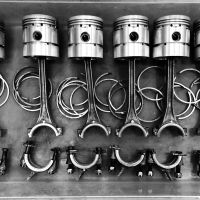Maximum Compression for 212ci 6 cylinder?
As some of you may know I’m going to be doing some internal work on my 1937 Hudson engine, new rings on the original pistons with cylinder hone and a valve job as well. Along with this I’m replacing the original head with a higher 7.25 compression head vs the original 6.25 head. The head is in very good condition but will still need a milling to true it up.
Since I’m needing to do some milling, I was wondering how high of compression I can go to on the 212ci splasher engine? If anyone has done this type of thing I’d love to also know your experiences.
Since I’m needing to do some milling, I was wondering how high of compression I can go to on the 212ci splasher engine? If anyone has done this type of thing I’d love to also know your experiences.
0
Comments
-
Not sure what head you are using but if it is a head from a 175" engine that 7.25 will end up higher on a 212" due to the increased swept volume of the latter. It's not hard to calculate the ratio on your particular engine by a few measurements and cc'ing the head and that is a good thing to do for certainty.
Limiting factors are the strength of the head studs and the low torque values given by Hudson suggest that too. There's not much meat around some of the studs closest to the cylinders. It could be that paying attention to the highest quality head gasket and sealing method will help without the temptation of over-torquing the head studs. I think o-ringing the block or head is something to think about if you're heading for the sky on the compression.
Increasing the compression by planing the head too much on flatheads can result in a squeezed up transition area (ie vertically) between the valves and cylinder, hurting breathing. I had thought I'd just weld up the chamber above the piston area to reduce volume without affecting the transition area, but it wasn't necessary at the modest increase I was doing.
The other concern is added pressure on the bearings with of course a 3-bearing main. Although Brough did develop a supercharged 212" for his sportiest model once he couldn't use the Eight engine, quoted at 140hp. There is no known history on whether these held together or not.
It's an interesting exercise and hopefully some of the resident experts will share their thoughts. What I have found with mine is that these engines can go amazingly well with just a bit of encouragement. It's worth reading the Sydney Morning Herald road test in one of my posts here, this was in 1936 with a high-compression option engine. They were very impressed and their one did 0-60 in 15 secs which is 0.6 secs behind a Terraplane Eight and far ahead of the standard 21 secs or so. It gives a much more responsive engine with increased fun factor. In particular distance to speed in top is reduced very significantly, and is quite noticeable on the road.0 -
I would be happy if all the cyls on my 37T had the same or very close compression and was close to 100psi0
Categories
- 36.9K All Categories
- 112 Hudson 1916 - 1929
- 20 Upcoming Events
- 92 Essex Super 6
- 28.6K HUDSON
- 571 "How To" - Skills, mechanical and other wise
- 995 Street Rods
- 151 American Motors
- 178 The Flathead Forum
- 49 Manuals, etc,.
- 78 Hudson 8
- 44 FORUM - Instructions and Tips on using the forum
- 2.8K CLASSIFIEDS
- 608 Vehicles
- 2.1K Parts & Pieces
- 77 Literature & Memorabilia
- Hudson 1916 - 1929 Yahoo Groups Archived Photos
